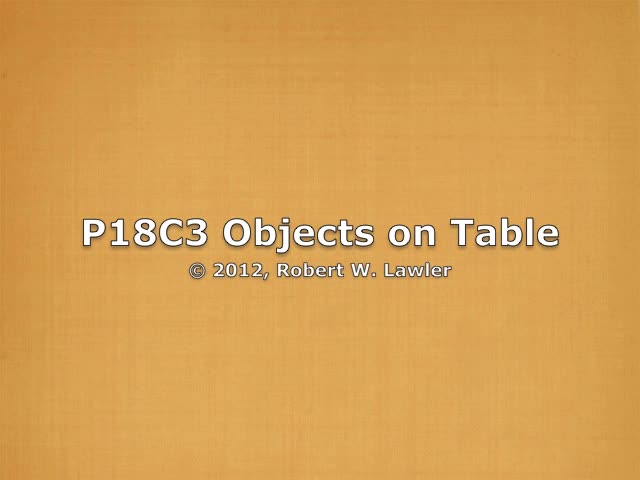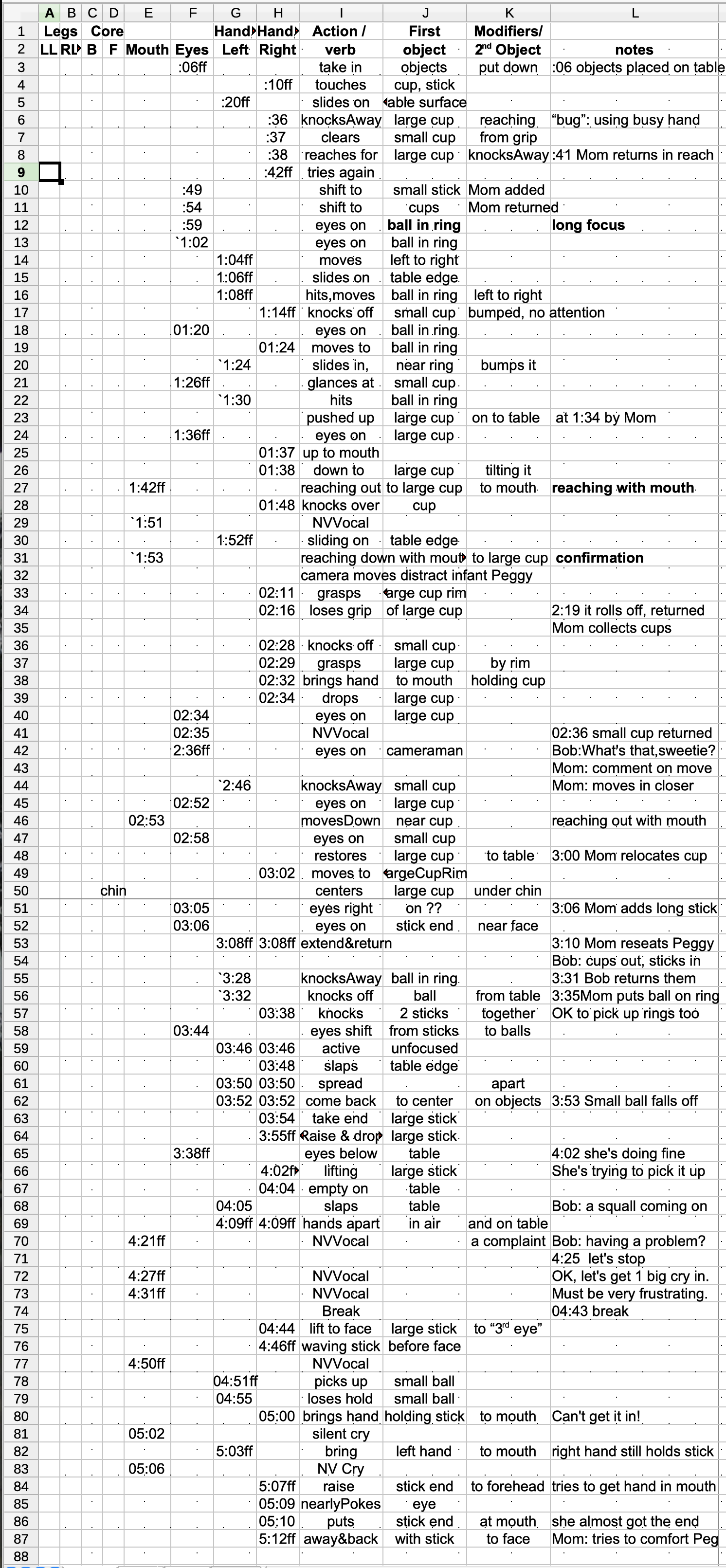
P18C3 Clip Notes
| Notes:n:nn | by Analyst 11/13/2025, updating resubtitlted transcription of 10/18/2024 |
| In the Clip | There is no disguising the chaos of this session. This was Peggy’s first exposure to these objects, which complicated those aspects essential to her age and the novelty for both her Mom and Bob. The need for support to free her hands for use and the crowding of so many objects in the range of her reach helped obscure whatever control she might have shown. The questions brought forward by the video are the relative importance of oral, manual, and visual senses in her situation. This is seen most directly in her “reaching out” with her mouth to contact objects as well as carry them to her mouth. Second is the extent to which one can see coordination of vision and touch and of the hands with each other. Peggy can grasp the cups because their concavity permits the opposition of fingers and thumb. The sticks are graspable because her fingers can circle the shaft. The rings and balls are moved by bumping, pushing (3:25) or striking (inadvertantly more often than intended). She did move the ball (at 4:55) with a transient loose handhold. The situation was frustrating for her. |
| In the Text | After the challenge of too many new things and their rolling away, it appears Bob may have cause more frustration by removing the cups, over which Peggy had some control, as shown by her bringing them to her mouth. (Why this frequency of mouthing? Taste ? Confirmation of some property? Biteability? The satisfaction of biting?) When she succeeds in grasping the long stick, a cylindrical rod, Peggy faces a dilemma. She brings it to her mouth but can not get anything in. Her hand is filled so full with the rod it will not fit. Mouthing the other end requires manipulation skills she can not quite manage. Poor baby. She has so much to learn about the world and her own means to control it. |
| In the Trace | After a minute of chaos, Peggy focuses on the ball seated in a ring. Moving from the left to that ball in ring, she hits and moves them, knocks away the small cup, pushes the ring, then the right hand slides in near the ring, bumping it. This hints at existing, early coordination of both hands, simple and not polished. When Mom inserts the large cup, attention shifts; Peggy shows she can grasp, move and twist the cup because it owns a dimension affording a hand of her size a fit. It is then, with an object where she has some manual control that she brings into play for touching her mouth, the first agent of grasping she had. What is going on? It’s not bizarre to see the infant as “feeling her way around” in a melee of uncomprehended impressions (Wm James’ “blooming, buzzing confusion”) searching for feelings of similarities and differences, even when they originate from sources we discriminate as disparate, as if sorting out what her actions accomplish by evaluating “after action reports” of the senses immediately, from which she will, as we have, invent the notion of “cause and effect.” The mouth and hands continue simultaneous activity as Peggy attempts persistently to bring an end of the long stick to her mouth, after frustrated in her first trials with the hand held end. This was a committed effort on her part. |
| Setting,Props | Brookline, Carriage House: objects subset, 2 ea of sticks, cups, rings, balls |
| Actors,Aims | Peggy and Mom; Bob on camera. Introducing the set of standard objects to Peggy |
| Episode A: | Bob: Hold on, Peggy. Be of good cheer. We have things here to play with. We don’t know what’s going to happen with them or what you’re going to do. Bob: Let’s see if we can keep them close by. The balls gonna roll off. Put the balls in things like that. Close enough for you to reach if you want…. [is Peggy trying to pull the surface towards her, as she did with cloths?]… [she moves the ring with ping-pong ball in it]… [Is she trying to bring her face down to the objects or the table itself?]… Oh. Bob: When she’s reaching out, although it’s hard to see on the camera, it looks as though she’s reaching out with her mouth open, as though she’s trying to get her head down on the things. Yeah, she is… That’s okay, Peggy. Don’t worry about it. |
| Episode B: 02:17 |
Mom: [As one cup rolls off the table] There it goes… [Bob returns it]… [a second cup rolls off the table] {Peggy: picks up larger cup and briefly mouths it, then vocalizes} Bob: [returns second cup] What’s that, sweetie? Mom: She actually picked up the yellow and was chewing on it for a brief instant while you were down on your hands and knees… Bob: There she goes, reaching out with her mouth again… |
| Episode C: 03:14 |
Bob: Maybe we have too many things. Let me take away these cups and see if she’s interested in the sticks at all… Well, maybe if she wants to pick up the rings, that’s perfectly fine, too. It’s going to be so hard. [The small ring and white ball fall off table] Bob: She’s doing fine. I think she’s trying to pick up that. Whoops… Sounds like a squall coming on… Having a problem, sweetie? Well, let’s stop right here.{P: lets out a small wail} Oh, okay. Let’s get one big cry. Ready? Oh, it must be very frustrating for some reason. [break in recording] Oh, she got the ball now, too. She had the ball… |
| Episode D: 04:59 |
Bob: That’s funny. She’s got it [the long rod] in her hand. It looks as though she wants to get the end in her mouth. There, she almost got the end…[and almost poked it in her eye] Well, that’s to be expected… You stop the experiment, and then she starts. |
| Action Trace | P018C3at  |
| Episode | |
| Summary by AI |
Peggy is presented with various objects (balls, cups, rings, sticks) on a table to explore. She appears to try pulling the surface closer and also moves a ring with a ping-pong ball. Observers note she often reaches with her mouth open, seemingly attempting to bring her face down to the objects. Cups roll off the table; one is returned, and Peggy briefly mouths the larger yellow cup and vocalizes. She repeatedly reaches toward objects with her mouth, suggesting mouth-centered exploration. The experimenters reduce clutter by removing cups to see if she’ll engage with sticks or rings. A small ring and white ball fall; Peggy seems to be trying to pick objects up but struggles. She becomes frustrated, lets out a small wail, and the session pauses for a moment. After a break, she grasps a long rod, attempts to get its end into her mouth, and nearly pokes her eye—seen as typical exploratory behavior. Notably, when the experiment is “stopped,” Peggy resumes exploring on her own. |
| Narrative by AI |
In a quiet room set up for observation, a caregiver gently encourages an infant named Peggy to explore a small collection of objects on a tabletop. The session begins with simple prompts—keeping items within reach, noting where they roll, and seeing how Peggy chooses to engage. The environment is minimal yet dynamic: cups, rings, a ping-pong ball, and a rod are introduced and rearranged as Peggy interacts with them. The tone is calm, supportive, and patient, allowing her to lead the pace of discovery. Peggy’s exploratory strategies are striking. Rather than only reaching with her hands, she often leans forward with her mouth open, as if trying to bring her head to the objects or the surface itself. She briefly mouths a cup, vocalizes, and continues to test what she can grasp or bring closer. At moments, it appears she’s attempting to pull the surface toward herself, echoing earlier behaviors seen with cloths. This multifaceted reaching—hands, head, and mouth—reflects how infants often coordinate different parts of the body to solve new motor challenges. As the objects shift and occasionally fall, the scene captures the natural ebb and flow of trial and error. A cup rolls off the table, a ring and ball slip away, and the caregiver returns them without fanfare. There’s a brief swell of frustration, acknowledged and soothed, which quickly gives way to renewed curiosity. The caregiver adjusts the setup—removing cups, offering sticks, leaving rings—to reduce distractions and see what holds Peggy’s interest. Throughout, the emphasis remains on letting her choose, not directing a particular outcome. A later moment stands out: Peggy grasps a long rod and appears intent on bringing its end to her mouth, nearly succeeding, and almost poking her eye in the process. The caregivers note this as expected—part of learning where objects begin and end and how to control them near the face. These small near-misses are common in early motor development, where perception, coordination, and intention are still being woven together. The balance between safety and freedom is palpable, managed through proximity, gentle commentary, and timely intervention. The session ends with an understated irony: when the formal experiment pauses, Peggy seems to dive back into activity on her own terms. It’s a reminder that exploration in infancy is continuous, often most authentic when it feels unstructured. The observation doesn’t offer grand conclusions, but it renders a vivid portrait of how infants investigate their world—through touch, mouth, movement, persistence, and a little frustration—supported by attentive adults who shape the environment while letting curiosity lead. |
| Link Index | Panel P018, Language Development, Object Exploration, Social Interactions |
| Themes, Interplay |
